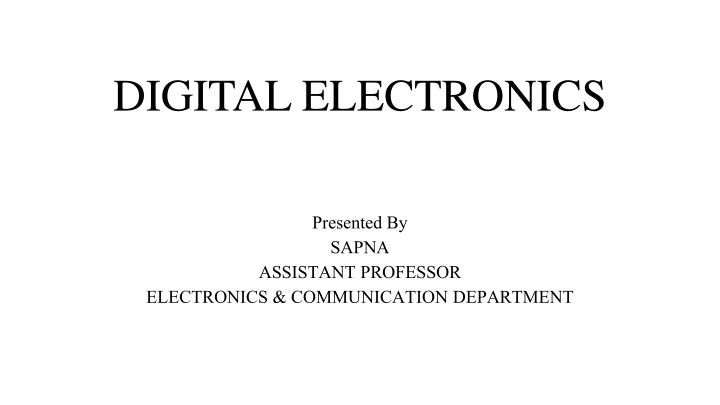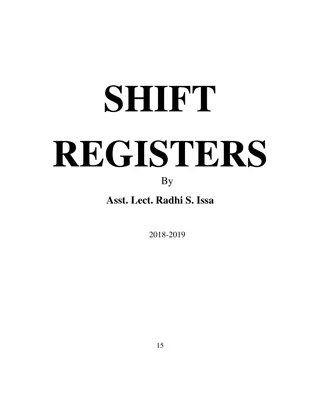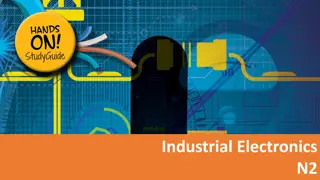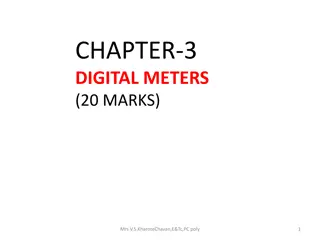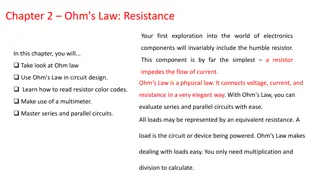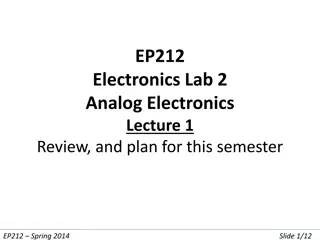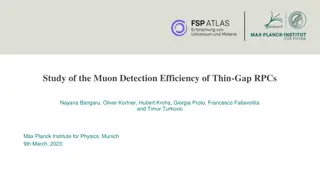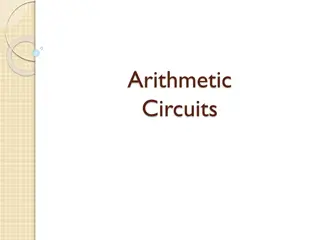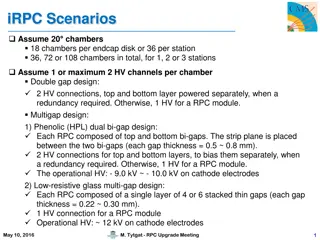DIGITAL ELECTRONICS
Introduction to digital electronics covering binary digits, logic levels, boolean algebra, logical operators (AND, OR, NOT), laws of boolean algebra, and operations like logical multiplication and addition. Learn about the fundamental concepts essential for understanding digital circuits and operations in computers.
Download Presentation

Please find below an Image/Link to download the presentation.
The content on the website is provided AS IS for your information and personal use only. It may not be sold, licensed, or shared on other websites without obtaining consent from the author.If you encounter any issues during the download, it is possible that the publisher has removed the file from their server.
You are allowed to download the files provided on this website for personal or commercial use, subject to the condition that they are used lawfully. All files are the property of their respective owners.
The content on the website is provided AS IS for your information and personal use only. It may not be sold, licensed, or shared on other websites without obtaining consent from the author.
E N D
Presentation Transcript
DIGITAL ELECTRONICS Presented By SAPNA ASSISTANT PROFESSOR ELECTRONICS & COMMUNICATION DEPARTMENT
BINARY DIGIT Each of the two digits in the binary system is called a bit. The word bit is a contraction of the words binary digit In a digital circuits, two different voltage levels are used to represent the two bits digit 1 is represented by the higher voltage level which is called logic HIGH or logic 1. Usually, digit 0 is represented by the lower voltage level which is called logic LOW or logic 0.
Logic Levels in Digital Circuits Positive logic level the higher value of voltage is considered as logic 1 and lower value of voltage as logic 0 Negative logic level if the lower value of voltage is considered as logic 1 and higher value of voltage as logic 0
BOOLEAN ALGEBRA It is used to perform the logical operations in digital computer. In digital computer True represent by 1 (high volt) and False represent by 0 (low volt) Logical operations are performed by logical operators. The fundamental logical operators are: 1. AND (conjunction) 2. OR (disjunction) 3. NOT (negation/complement)
AND Operator It performs logical multiplication and denoted by (.) dot. X Y 0 0 0 1 1 0 1 1 OR Operator It performs logical addition and denoted by (+) plus. X Y X+Y 0 0 0 0 1 1 1 0 1 1 1 1 X.Y 0 0 0 1
NOT Operator It performs logical negation and denoted by (-) bar. It operates on single variable. X 0 1 X 1 0 (means complement of x) Commutative Law Commutativity is a widely used mathematical term that refers to the ability to change the order of something without changing the end result. x + y = y + x x . y = y . x Associative Law These laws state that x + (y + z) = (x + y) + z x . (y . z) = (x . y) . z
Identity Law In Boolean algebra there exist identity elements 0 (additive element) and 1 (multiplicative identity) such that x + 0 = x x.1 = x Inverse Law There exists an inverse such that x + x = 1 x.x = 0 Idempotent Law This law states that x + x = x x.x = x
Distributive Law This law states that x + (y . z) = (x + y) . (x + z) x + (y . z) = (x + y) . ( x + z) Absorption Law This law states that x +x.y = x x+x .y = x+y x.((x+y)+z) = z (x+y).(x +z).(y+z)=(x+y).(x +z) (x.y)+(x .z)+(y.z) = (x.y)+(x .z) x.(x+y) = x x.(x +y) = x.y x+((x.y).z) = x
Elimination Law x + (x' . y) = x + y x.(x' + y) = x.y Consensus theorem x.y + x'.z + y.z = x.y + x'.z or dual form as below (x+ y).(x' + z).(y + z) = (x + y).(x' + z) Involution Law This law states that (x ) = x
De Morgans Law This is a very interesting and important law which is useful in designing logic networks. This law states that (x+y) = x .y (x.y) = x + y
Logic Gate A gate is an digital circuit which operates on one or more signals and produce single output. Gates are digital circuits because the input and output signals are denoted by either 1(high voltage) or 0(low voltage). There are three basic gates and are: 1. AND gate 2. OR gate 3. NOT gate
AND Gate The AND gate is an electronic circuit that gives a high output (1) only if all its inputs are high. AND gate takes two or more input signals and produce only one output signal. Truth table Input A 0 0 1 1 Input B 0 1 0 1 Output AB 0 0 0 1
OR Gate The OR gate is an electronic circuit that gives a high output (1) if one or more of its inputs are high. OR gate also takes two or more input signals and produce only one output signal. Input A 0 0 1 1 Input B 0 1 0 1 Output A+B 0 1 1 1
NOT Gate The NOT gate is an electronic circuit that gives a high output (1) if its input is low . NOT gate takes only one input signal and produce only one output signal. The output of NOT gate is complement of its input. It is also called inverter. Truth table Input A Output A 0 1 1 0
NAND Gate Known as a universal gate because ANY digital circuit can be implemented with NAND gates alone. X Y Z 0 0 1 0 1 1 1 0 1 1 1 0 X Z Y A NAND Gate is constructed by connecting a NOT Gate at the output terminal of the AND Gate. The output of NAND gate is high ( 1 ) if at least one of its inputs is low ( 0 ). The output of NAND gate is low ( 0 ) if all of its inputs are high ( 1 ).
NOR Gate- A NOR Gate is constructed by connecting a NOT Gate at the output terminal of the OR Gate. The output of NOR gate is high ( 1 ) if all of its inputs are low ( 0 ). The output of NOR gate is low ( 0 ) if any of its inputs is high ( 1 ). Logic Symbol- The logic symbol for NOR Gate is as shown below-
Truth Table of NOR Gate- The truth table for NOR Gate is as shown below- B Y = A + B A 0 0 1 0 1 0 1 0 0 1 1 0
XOR Gate XOR gate is a digital logic gate that gives a true (1 or HIGH) output when the number of true inputs is odd. Various representations of an XOR gate 18
X-NOR Gate The X-NOR gate is the complement of the XOR gate. It is a hybrid gate. Simply, it is the combination of the XOR gate and NOT gate. The output level of the XNOR gate is high only when both of its inputs are the same, either 0 or 1. The symbol of the XNOR gate is the same as XOR, only complement sign is added. Sometimes, the XNOR gate is also Equivalence gate. called the
Realization of other gates using Universal gate NOR Gate as an Inverter Gate + = X X X (Before Bubble) Z = X X X Z 0 1 Equivalent to Inverter 1 0 20
NOR Gate as an OR Gate X + Y X Y = + = + Z X Y X Y NOR Gate Inverter X Y Z 0 0 0 0 1 1 Equivalent to OR Gate 1 0 1 1 1 1 21
NOR Gate as an AND Gate X Y X = + = = Z X Y X Y X Y Y NOR Gate Inverters X Y Z 0 0 0 0 1 0 Equivalent to AND Gate 1 0 0 1 1 1 22
NOR Gate Equivalent of AOI Gates AND OR INVERTER 23
NAND Gate as an Inverter Gate = X X X (Before Bubble) Z = X X X Z 0 1 Equivalent to Inverter 1 0 24
NAND Gate as an AND Gate X Y X Y = = Z X Y X Y Inverter NAND Gate X Y Z 0 0 0 0 1 0 Equivalent to AND Gate 1 0 0 1 1 1 25
NAND Gate as an OR Gate X Y X = = + = + Z X Y X Y X Y Y NAND Gate Inverters X Y Z 0 0 0 0 1 1 Equivalent to OR Gate 1 0 1 1 1 1 26
NAND Gate Equivalent to AOI Gates AND OR INVERTER 27
Standard Forms of Boolean Expressions Sum of product(SOP) SOP form is a set of product(AND) terms that are summed(OR) together. When an expression or term is represented in a sum of binary terms known as minterms and sum of products. A .B .C + A .B.C + A.B.C Product of sum(POS) A technique of explaining a Boolean expression through a set of max terms or sum terms, is known as POS (product of sum). (A+B'+C).(A'+B+C).(A'+B+C').(A'+B'+C')
SOP POS SOP stands for Sum of Products. POS stands for Product of Sums. 1 It is a technique of defining the boolean terms as the sum of product terms. It is a technique of defining boolean terms as a product of sum terms. 2 It prefers minterms. It prefers maxterms. 3 In the case of SOP, the minterms are defined as m . In the case of POS, the Maxterms are defined as M 4 It gives HIGH(1) output. It gives LOW(0) output. 5 In SOP, we can get the final term by adding the product terms. In POS, we can get the final term by multiplying the sum terms. 6
Canonical SOP Form This is the standard form of Sum of Product. It is formed by Ring the minterms of the function for which the output is true. This is also known as Sum of Min terms or Canonical disjunctive normal form (CDNF).
For example, a functions truth table is given below. For this function the canonical SOP expression is F = ( m1, m2, m3, m5) Which means that the function is true for the min terms {1, 2, 3, 5}. By expanding the summation we get. F = m1+ m2+ m3+ m5 Now putting min terms in the expression F = A B C + A BC + A BC + AB C Canonical form contains all inputs either complemented or non- complemented in its product terms.
Non-Canonical SOP Form The product terms are not the min terms but they are simplified. Let s take the function in canonical form as an example. F = A B C + A BC + A BC + AB C F = A B C + A B(C + C) + AB C F = A B C + A B(1) + AB C F = A B C + A B + AB C This expression is still in Sum of Product form but it is non-canonical or non- standardized form
Minimal SOP Form Minimal SOP form is preferred because it uses the minimum number of gates and input lines. It is commercially beneficial because of its compact size, fast speed, and low fabrication cost.
Conversion from Minimal SOP to Canonical SOP Form Minimal SOP form F = A B + B C The multiply A B with (C+C ) because (C+C = 1). The term B C is missing input A. so it will be multiplied with (A+A ) term A B is missing input C. So we will F = A B(C + C ) + B C(A + A ) F = A BC + A BC + AB C + A B C Now, this expression is in canonical form.
Duality theorem According to the duality principle, if we have postulates or if we have theorems of Boolean Algebra for any one type of operation then the operation can be converted into another type of operation. In other words AND can be converted to OR and OR can be converted into AND We can interchange '0 with 1', '1 with 0', '(+) sign with (.) sign' and '(.) sign with (+) sign' to perform dual operation. T This principle ensures that if a theorem is proved using postulates of Boolean algebra, then the dual of this theorem automatically holds and there is no requirement of proving it separately. Duality Principle: The Duality principle states that when both sides are replaced by their duals the Boolean identity remains valid.
Boolean Expressions and Their Corresponding Duals Given Expression Dual Given Expression Dual 0 = 1 1 = 0 A. (A+B) = A A + A.B = A 0.1 = 0 1 + 0 = 1 AB = A + B A+B = A.B A.0 = 0 A + 1 = 1 (A+C) (A +B) = AB + AC AC + AB = (A+B). (A+C) A.B = B. A A + B = B + A A+B = AB + AB +AB AB = (A+B).(A+B).(A+B) A.A = 0 A + A = 1 AB + A + AB = 0 ((A+B)).A.(A+B) = 1 A. (B.C) = (A.B). C A+(B+C) = (A+B) + C
Karnaugh Map(K-Map) method The K-map is a systematic way of simplifying Boolean expressions. With the help of the K-map method, we can find the simplest POS and SOP expression, which is known as the minimum expression The following steps used to solve the expressions using K-map: 1.First, we find the K-map as per the number of variables. 2.Find the maxterm and minterm in the given expression. 3.Fill cells of K-map for SOP with 1 respective to the minterms. 4.Fill cells of the block for POS with 0 respective to the maxterm. 5.Next, we create rectangular groups that contain total terms in the power of two like 2, 4, 8, and try to cover as many elements as we can in one group. 6.With the help of these groups, we find the product terms and sum them up for the SOP form.
2 Variable K-map 3-variable K-map
Quine McCluskey Method The quine-McCluskey method also called the tabulation method is a very useful and convenient method for simplification of the Boolean functions for a large number of variables (greater than 4). This method is useful over K-map when the number of variables is larger for which K-map formation is difficult. This method uses prime implicants for simplification. This method includes the use of minterms, and prime implicants and obtains essential prime implicants which are further used in the simplified boolean functions.
Steps for Quine McCluskey Method: 1.Arrange the given minterms according to the number of ones present in their binary representation in ascending order. 2.Take the minterms from the continuous group if there is only a one-bit change to make their pair. 3.Place the - symbol where there is a bit change accordingly and keep the remaining bits the same. 4.Repeat steps 2 to 3 until we get all prime implicants (when all the bits present in the table are different). 5.Make a prime implicant table that consists of the prime implicants (obtained minterms) as rows and the given minterms (given in problem) as columns. 6.Place 1 in the minterms (cell) which are covered by each prime implicant. 7.Observe the table, if the minterm is covered by only one prime implicant then it is an essential to prime implicant. 8.Add the essential prime implicants to the simplified boolean function.
Simplify using tabulation method : F(A,B,C,D) = m(0,1,2,4,6,8,9,11,13,15) TABLE 1 TABLE-2 Group Minterm A B C D Group Pair A B C D 0 0 0 0 0 0 (0,1) (0,2) (0,4) (0,8) 0 0 0 0 0 0 0 0 0 0 0 0 0 1 2 4 8 0 0 0 1 0 0 1 0 0 1 0 0 1 0 0 0 1 (1,9) (2,6) (4,6) (8,9) 0 0 1 0 1 0 0 1 0 1 0 0 1 6 9 0 1 1 0 1 0 0 1 2 (9,11) (9,13) 1 1 0 0 1 1 11 13 1 1 0 1 1 0 1 1 2 3 (11,15) (13,15) 1 1 1 1 1 1 4 15 1 1 1 1 3
TABLE-3 Group Quad A B C D (0,1,8,9) (0,2,4,6) 0 0 0 0 0 1 (9,11,13,15) 1 1 PRIME IMPLICANT TABLE Minterms 0 1 2 4 6 8 9 11 13 15 Prime Implicants B C (0,1,8,9) 1 1 1 1 A D'(0,2,4,6) 1 1 1 1 AD(9,11,13,15) 1 1 1 1 Simplified Boolean function = B C + A D + AD
Transistor-Transistor Logic (TTL) The Transistor-Transistor Logic (TTL) is a logic family made up of BJTs (bipolar junction transistors). As the name suggests, the transistor performs two functions like logic as well as amplifying. TTL logic includes several transistors that have several emitters as well as several inputs. The types of TTL or transistor-transistor logic mainly include Standard TTL, Fast TTL, Schottky TTL, High power TTL, Low power TTL & Advanced Schottky TTL. The designing of TTL logic gates can be done with resistors and BJTs
Low-power TTL operates with a 33ns switching speed to reduce the power consumption like 1 mW. At present, this was replaced through CMOS logic. High-speed TTL has faster switching as compared with normal TTL like 6ns. However, it has high power dissipation like 22 mW. Schottky TTL was launched in the year 1969 and it is used to avoid the storage of charge to enhance the switching time by using Schottky diode clamps at the gate terminal. These gate terminals operate in 3ns however it includes high power dissipation like 19 Mw Low power TTL uses high resistance values from low power TTL. The Schottky diodes will provide a good blend of speed as well as decreased power utilization like 2 mW. This is the most general type of TTL, used like glue logic within microcomputers, basically replaces the past sub-families like L, H & S. The fast TTL is used to increase the transition from low-to-high.
